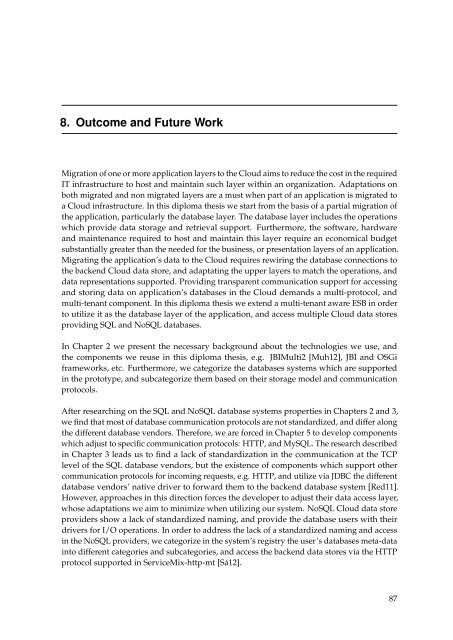Diploma Thesis Santiago Gómez Sáez - IAAS
Diploma Thesis Santiago Gómez Sáez - IAAS
Diploma Thesis Santiago Gómez Sáez - IAAS
Create successful ePaper yourself
Turn your PDF publications into a flip-book with our unique Google optimized e-Paper software.
8. Outcome and Future Work<br />
Migration of one or more application layers to the Cloud aims to reduce the cost in the required<br />
IT infrastructure to host and maintain such layer within an organization. Adaptations on<br />
both migrated and non migrated layers are a must when part of an application is migrated to<br />
a Cloud infrastructure. In this diploma thesis we start from the basis of a partial migration of<br />
the application, particularly the database layer. The database layer includes the operations<br />
which provide data storage and retrieval support. Furthermore, the software, hardware<br />
and maintenance required to host and maintain this layer require an economical budget<br />
substantially greater than the needed for the business, or presentation layers of an application.<br />
Migrating the application’s data to the Cloud requires rewiring the database connections to<br />
the backend Cloud data store, and adaptating the upper layers to match the operations, and<br />
data representations supported. Providing transparent communication support for accessing<br />
and storing data on application’s databases in the Cloud demands a multi-protocol, and<br />
multi-tenant component. In this diploma thesis we extend a multi-tenant aware ESB in order<br />
to utilize it as the database layer of the application, and access multiple Cloud data stores<br />
providing SQL and NoSQL databases.<br />
In Chapter 2 we present the necessary background about the technologies we use, and<br />
the components we reuse in this diploma thesis, e.g. JBIMulti2 [Muh12], JBI and OSGi<br />
frameworks, etc. Furthermore, we categorize the databases systems which are supported<br />
in the prototype, and subcategorize them based on their storage model and communication<br />
protocols.<br />
After researching on the SQL and NoSQL database systems properties in Chapters 2 and 3,<br />
we find that most of database communication protocols are not standardized, and differ along<br />
the different database vendors. Therefore, we are forced in Chapter 5 to develop components<br />
which adjust to specific communication protocols: HTTP, and MySQL. The research described<br />
in Chapter 3 leads us to find a lack of standardization in the communication at the TCP<br />
level of the SQL database vendors, but the existence of components which support other<br />
communication protocols for incoming requests, e.g. HTTP, and utilize via JDBC the different<br />
database vendors’ native driver to forward them to the backend database system [Red11].<br />
However, approaches in this direction forces the developer to adjust their data access layer,<br />
whose adaptations we aim to minimize when utilizing our system. NoSQL Cloud data store<br />
providers show a lack of standardized naming, and provide the database users with their<br />
drivers for I/O operations. In order to address the lack of a standardized naming and access<br />
in the NoSQL providers, we categorize in the system’s registry the user’s databases meta-data<br />
into different categories and subcategories, and access the backend data stores via the HTTP<br />
protocol supported in ServiceMix-http-mt [Sá12].<br />
87

















